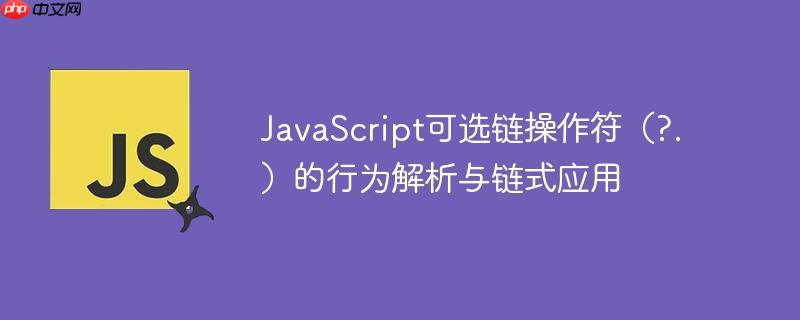
JavaScript中的可选链操作符(?.)提供了一种安全访问对象属性或调用函数的方式。当其左侧操作数为undefined或NULL时,表达式会立即短路并返回undefined,而非抛出错误。理解其短路机制,尤其是在链式调用中,对于避免运行时错误和编写健壮的代码至关重要。本文将深入探讨?.的精确行为,并通过实例解析其在不同链式结构下的表现。
1. 可选链操作符(?.)基础
可选链操作符(?.)是ES2020引入的一个语法特性,旨在简化对可能为null或undefined的对象属性的访问。在传统的JavaScript中,如果尝试访问一个undefined或null值的属性,会抛出TypeError。
例如:
const user = null; // console.log(user.address); // Uncaught TypeError: Cannot read properties of null (reading 'address') const profile = {}; // console.log(profile.data.name); // Uncaught TypeError: Cannot read properties of undefined (reading 'data')
使用可选链操作符,可以优雅地处理这种情况:
const user = null; console.log(user?.address); // undefined (不会报错) const profile = {}; console.log(profile?.data?.name); // undefined (不会报错)
当?.左侧的表达式结果为null或undefined时,整个表达式会立即“短路”(short-circuit),停止后续的属性访问或函数调用,并直接返回undefined。
立即学习“Java免费学习笔记(深入)”;
2. 理解短路机制
短路是理解?.行为的关键。它意味着一旦遇到null或undefined,表达式的求值就会立即停止。
考虑以下两种情况:
2.1 传统点操作符(.)的链式访问
当使用传统的点操作符进行链式属性访问时,如果链条中的任何一个中间环节为null或undefined,后续的属性访问将立即导致TypeError。
let a = {}; console.log(a.n); // undefined // 尝试访问 undefined 的属性 'n' // console.log(a.n.n.n.n.n.n.n); // Uncaught TypeError: Cannot read properties of undefined (reading 'n')
在这个例子中,a.n的结果是undefined。接下来,当尝试访问undefined的属性n时,就会抛出TypeError。
2.2 可选链操作符(?.)的短路效应
?.的短路特性使得它在遇到null或undefined时,不仅停止当前属性的访问,而且使整个链式表达式返回undefined。
情况一:仅在起始处使用?.
let a = {}; // a 是一个空对象,不是 null 或 undefined。 // 因此 a?.n 的行为等同于 a.n。 console.log(a?.n); // undefined // 接下来,a?.n 的结果是 undefined。 // 尝试访问 undefined 的属性 'n',会抛出 TypeError。 // console.log(a?.n.n.n.n.n.n.n); // Uncaught TypeError: Cannot read properties of undefined (reading 'n')
这里,a本身不是null或undefined,所以a?.n会正常评估为a.n,其结果是undefined。由于?.只作用于紧邻它的左侧操作数,后续的.n操作符是在对一个undefined值进行属性访问,因此会抛出TypeError。这与上述传统点操作符的行为一致。
情况二:链式使用?.
当链条中多个环节都使用?.时,短路效应会贯穿整个链条。
let a = {}; // a.n 的结果是 undefined。 // 此时,a?.n 评估为 undefined。 // 接下来遇到第二个 ?.n,由于其左侧操作数(a?.n 的结果,即 undefined)是 nullish, // 整个表达式会在这里短路,并返回 undefined。 console.log(a?.n?.n.n.n.n.n.n); // undefined
在这个例子中,a.n的结果是undefined。当评估到a?.n?.n时,第一个?.(a?.n)正常评估为undefined(因为a不是null或undefined)。接着,第二个?.(?.n)的左侧操作数是undefined。根据可选链的规则,它会立即短路,使得整个表达式的结果为undefined,而不会继续尝试访问后续的.n属性,从而避免了TypeError。
3. 总结与最佳实践
- ?.只对其紧邻的左侧操作数生效。 如果左侧操作数不是null或undefined,它会像常规的点操作符一样继续求值。
- 短路发生在?.遇到null或undefined时。 一旦发生短路,整个表达式(从短路点到末尾)将返回undefined,不再执行后续的属性访问或函数调用。
- 在链式访问中,仅在可能出现null或undefined的环节使用?.。 如果链条中的某个中间结果可能为null或undefined,且你希望在这种情况下整个表达式安全地返回undefined,那么在该环节之后的所有点操作符都应该改为?.。
示例:
const data = { user: { profile: { name: "Alice" } } }; // 假设 profile 可能不存在 console.log(data.user?.profile?.name); // "Alice" const data2 = { user: {} // profile 不存在 }; console.log(data2.user?.profile?.name); // undefined (在 profile?.name 处短路) const data3 = {}; // user 不存在 console.log(data3.user?.profile?.name); // undefined (在 user?.profile 处短路) // 错误示范:如果 user.profile 可能为 null/undefined,但后续没有 ?. // const data4 = { user: { profile: null } }; // console.log(data4.user?.profile.name); // TypeError: Cannot read properties of null (reading 'name') // 解释:data4.user?.profile 评估为 null。后续的 .name 尝试访问 null 的属性,导致错误。
通过理解?.的精确短路行为,我们可以更准确地使用它来编写健壮、可读性强的JavaScript代码,有效避免因访问不存在属性而导致的运行时错误。



















